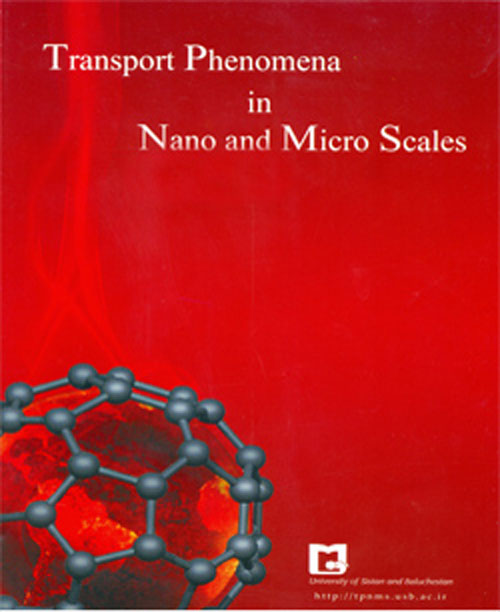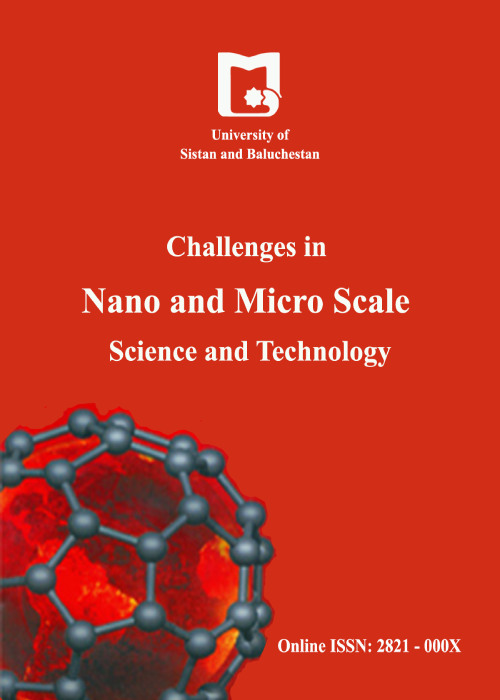فهرست مطالب

Journal of Transport Phenomena in Nano and Micro Scales
Volume:6 Issue: 1, Winter - Spring 2018
- تاریخ انتشار: 1396/11/14
- تعداد عناوین: 7
-
-
Pages 1-12In this project,Bio-based carbon nanotubes (CNTs) have received considerable research attention due to their comparative advantages of high level stability, simplistic use, low toxicity and overall environmental friendliness. New potentials for improvement in heat transfer applications are presented due to their high aspect ratio, high thermal conductivity and special surface area. Phonons have been identified as being responsible for thermal conductivities in carbon nanotubes. Therefore, understanding the mechanism of heat conduction in CNTs involves investigating the difference between the varieties of phonon modes and knowing the kinds of phonon modes that play the dominant role. In this review, a reference to a different number of studies is made and in addition, the role of phonon relaxation rate mainly controlled by boundary scattering and three-phonon Umklapp scattering process was investigated. Results show that the phonon modes are sensitive to a number of nanotube conditions such as: diameter, length, temperature, defects and axial strain. At a low temperature (Keywords: Carbon nanotubes, Phonons, Thermal conductivity, Umklapp process
-
Pages 13-26In this study, the least square method is applied to study the laminar flow, heat transfer and microrotation of MgO-Ag/water micropolar hybrid nanofluid in a permeable channel. The bottom wall is hot and coolant fluid is injected into the channel from the top wall. The base fluid in the channel is water and volume fraction of nanoparticle (50% Ag and 50% MgO by volume) is between 0 and 0.02. By comparing the results which are obtained from Least Square Method (LSM) with those of obtained from numerical method (fourth order Rung-Kutta method), a good conformity can be seen between them. The effects of different parameters such as Reynolds number, volume fraction of nanoparticles and microrotation factor of nanoparticles on flow field and heat transfer are examined. The results show that by increasing Reynolds number, the temperature of the hybrid nanofluid reduces and the microrotation parameter near the hot wall decreases and near the permeable wall increases. Also, heat transfer increases, especially in high Reynolds numbers and volume fraction of nanoparticles, when the hybrid nanofluid are used instead of common nanofluid.Keywords: Micropolar hybrid nanofluid, Permeable channel, Least square method, Heat transfer
-
Pages 27-38In this paper a numerical investigation is performed to study the effects of different nanofluids on convective heat transfer enhancement in a partitioned square cavity subject to different shapes of nanoparticle using water-SiO2 nanofluid. This study has been carried out to analyze the effects of SiO2 nanoparticle, its volumetric fraction between 2 and 4%, and nanoparticle shape (i.e. blades, platelets, cylindrical, bricks, and spherical), on the fluid flow and heat transfer characteristics. The overall continuity, momentum, and energy equations are solved by using the finite-volume method and the SIMPLE algorithm. The influence of related parameters such as Rayleigh number (Ra=105 to 107) and height of partition (h=0.1, 0.3, 0.5H) are studied. Based on the results, independent of nanoparticle shape, the streamlines and isotherms are extremely affected by Rayleigh number and height of partition. For a fixed amount of the partition height, average Nusselt number increases as the Rayleigh number rises.Keywords: natural convection, Nanofluid, Nanoparticle shape, Cavity, SiO2
-
Pages 39-48The development of high-performance thermal systems has increased interest in heat transfer enhancement techniques. The application of additives to heat transfer liquids is one of the noticeable effort to enhance heat transfer. In this paper two-dimensional unsteady incompressible nanofluid flow in a confined jet at the laminar flow regime is numerically investigated. The Mixture model is considered to simulate the nanofluid jet flow inside a channel. The governing mass, momentum equations for mixture and dispersed phase and energy equation for mixture are solved using the finite volume method. The result showed the relative velocity is very small and negligible and the nanoparticles concentration distribution is uniform. Results have been reported at different Reynolds numbers for steady asymmetric jet development at various values of the duct-to-jet width ratio (aspect ratio) and different volume fractions of nanoparticles. The present computations are in a very good agreement with experimental and numerical results in open literature.Keywords: Mixture model, Nanofluids, Aspect ratio, Nusselt number, Recirculation region
-
Pages 49-59This study discusses the application of Taguchi method in assessing minimum entropy generation and maximum heat transfer rate for natural convection in an enclosure embedded with isothermal cylinder. The simulations were planned based on Taguchis L25 orthogonal array with each trial performed under different conditions of position and aspect ratio (AR) of the cylinder. The thermal lattice Boltzmann based on D3Q19 methods without any turbulent submodels was purposed to simulate the flow and thermal fields. A relaxation time method with the stability constants is introduced to solve turbulent natural convection problems. Signal-to-noise ratios (S/N) analysis were carried out in order to determine the effects of process parameters and optimal factor settings. Isotherms, streamlines and Nusselt numbers were obtained and discussed. Total entropy generations in various cases are also reported and optimum case is presented based on minimum entropy generation and maximum heat transfer rate. Finally, confirmation tests verified that Taguchi method achieved optimization of heat transfer rate with sufficient accuracy.Keywords: Taguchi method, Lattice Boltzmann model, natural convection, cylinder
-
Pages 60-71This article presents the heat and mass transfer characteristics of unsteady MHD flow of a viscous, incompressible and electrically conducting micropolar fluid in the presence of viscous dissipation and radiation over a porous stretching sheet with chemical reaction. The governing partial differential equations (PDEs) are reduced to ordinary differential equations (ODEs) by applying suitable similarity transformations which are then solved numerically using fourth order Runge-Kutta method. The results are depicted graphically for velocity, angular velocity, temperature and concentration profiles for various values of parameters such as unsteadiness parameter, magnetic parameter, porous parameter, thermal Grashof number, solutal Grashof number, Prandtl number, thermal radiation parameter, Eckert number, Schmidt number and chemical reaction parameter. To check the accuracy of our numerical code, comparison is made with the existing results. The influence of various parameters on skin friction coefficient, couple stress and rates of heat and mass transfer coefficients are presented numerically in tabular form.Keywords: Micropolar fluid, porous medium, thermal radiation, viscous dissipation, chemical reaction
-
Pages 72-78This work introduces the novel gelatin/chitosan blend scaffolds containing different amounts of functionalized multi-walled carbon nanotubes (f-MWCNTs) up to 0.1wt%, which were prepared by freeze drying (freezing and lyophilization). The composite scaffolds were characterized by Fourier transformed infrared spectroscopy (FTIR) to distinguish the functional groups and different bonds in the structure of composite, and field-emission scanning electron microscope (FE−SEM) to evaluate the morphology of scaffolds. The scaffolds with the porosity of 89−93% and pore size of 40−200µm could be obtained by freezing at −20 °C and subsequent lyophilization. The porosity and swelling ratio of scaffolds were decreased, but the pore diameter was increased with an addition of f-MWCNTs. The electrical conductivity of incorporated scaffolds showed a significant increase with f-MWCNTs at an amount of 0.05wt%, and could achieve to those of the heart muscle. Compressive mechanical properties of the scaffolds revealed that the incorporation of f-MWCNTs led to significantly stiff the biopolymeric scaffold. The findings indicate that these novel fabricated composite scaffolds have microstructurally and electrically the potential to use in cardiac tissue engineering applications.Keywords: Functionalized multi-walled carbon nanotube, Electrical properties, Gelatin, Chitosan, Cardiac tissue engineering


